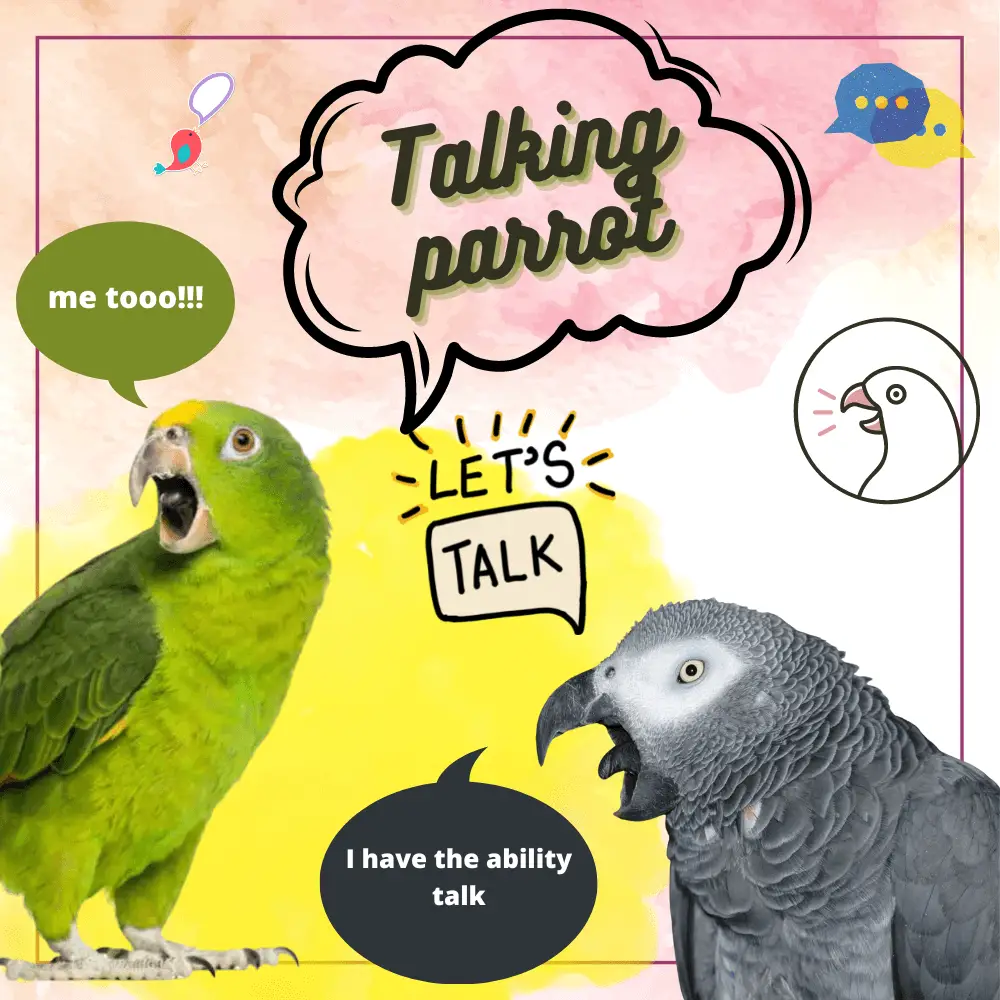Talking parrot: Commonly, we speak of parrots to refer to members of the order Psittaciformes. This group of birds is made up of Psittacidae, cockatoos (Cacatuoidea), and strigopidae. They all have one feature in common that attracts a lot of attention: they are able to imitate sounds.
Some species of parrots that live in captivity can learn to imitate human words. This is why it is said that parrots can talk. However, this ability can be more or less limited depending on the species, in fact, some of them cannot even speak. In this article Talking Parrot – Characteristics, Types, and Breeds we will tell you which are the best talking parrots and we will also explain why they do so.
Characteristics of parrots
Here are some of the main characteristics of parrots:
- Parrot form: his body is broad and strong and he is always in an upright position.
- Parrot fingers: parrots have 4 fingers. Two of them are forward-facing and the others are rear-facing. This is what allows them to spend a lot of time resting on the branches of trees.
- Parrot beak: they have a very large beak, curved towards the case, and specialized in the opening of fruits with shells.
- Parrot lives: these birds are not migratory, so they spend their entire lives in the same place.
- Are parrots herbivores: most parrots feed on seeds? They supplement their diet with flowers, leaves, roots, resin, bark, fruit pulp, and arthropods. The parrots of the subfamily (Loriinae) prefer the nectar and pollen of flowers. Find out all about parrot food.
- Parrot breeding: during the breeding season, these animals build isolated nests in the trunks of trees. This is where they reproduce with a partner during the mating season, or even throughout life. Only in a few species does polygamous behavior appear.
- Parrot Social: most species form large groups that sleep and feed together. In addition, several groups can also socialize with each other.
- Intelligence of parrots: alongside corvids, they are birds with the greatest cognitive abilities. This is due to the fact that they have a very large brain with a very developed brain.
- Parrot sounds: they have brain structures specialized in language. They have a special brain nucleus that allows them to learn sounds throughout their lives.
- Parrot endangered: 28% of Psittaciformes (111 species) are considered endangered or in a vulnerable situation. 56% of Psittaciformes see their population in decline. The destruction of their habitat and the capture to sell them as pets are the two main threats to them.
Why do parrots talk?
Many species of parrots that live in captivity copy and reproduce human words. But, can we really say that parrots talk? A few years ago we would say no, but nowadays we consider the word to speak to mean “to put out words”. Thus, it is possible to say that there are talking parrots.
Parrots learn and memorize our words and later repeat them. But why do parrots talk? The answer to this question lies in their behavior in the wild. In short, this is because parrots are very social birds. They imitate our words because that’s what they would do with other individuals of their own species if they were free.
The vocal training of parrots begins as soon as they come out of the egg, that is to say, they learn their first vocalizations from their parents. Then they begin to socialize with other individuals of their species. It is from them that they will learn new sounds, which they will imitate and reproduce, giving them their personal touch. In fact, the sounds that parrots make will depend on their geographical area, therefore parrots, like us, have dialects.
Here are some of the functions that parrot vocal learning has:
- Sexual Selection: They learn and repeat sounds to attract, seduce and maintain their monogamous relationship. In many parrot breeds, the male mimics the female’s calls to let her know he’s interested.
- Territory Defence: Like all monogamous birds, parrots defend their nesting territory. Their objective is to prevent other pairs of the same species from stealing their nest or throwing their eggs on the ground. It is more than usual for both members of the pair to make calls or sing together.
- Coordinated Foraging: Many species of parrots gather in flocks or flocks to feed together. Generally, a more experienced specimen guides the others and shows them what they can eat. This proves that parrots learn from other individuals of their species. Also, it is common for groups to constantly come together and break apart, joining with other groups from neighboring territories. For this reason, it is crucial that they know how to recognize each other. In fact, it is very common for them to imitate the call of other specimens in order to communicate with them. It is assumed that these calls are for the purpose of negotiating or exchanging food information.
- Avoid predation: Many parrots congregate at night and when foraging to avoid being eaten by other animals. When a predator approaches, they give alarm calls and everyone is on guard. However, it has not yet been proven that these calls are the result of learning.
What parrots talk?
There are many species of talking parrots, so we are going to tell you about the most communicative species or those that have something interesting to tell us.
African grey parrot
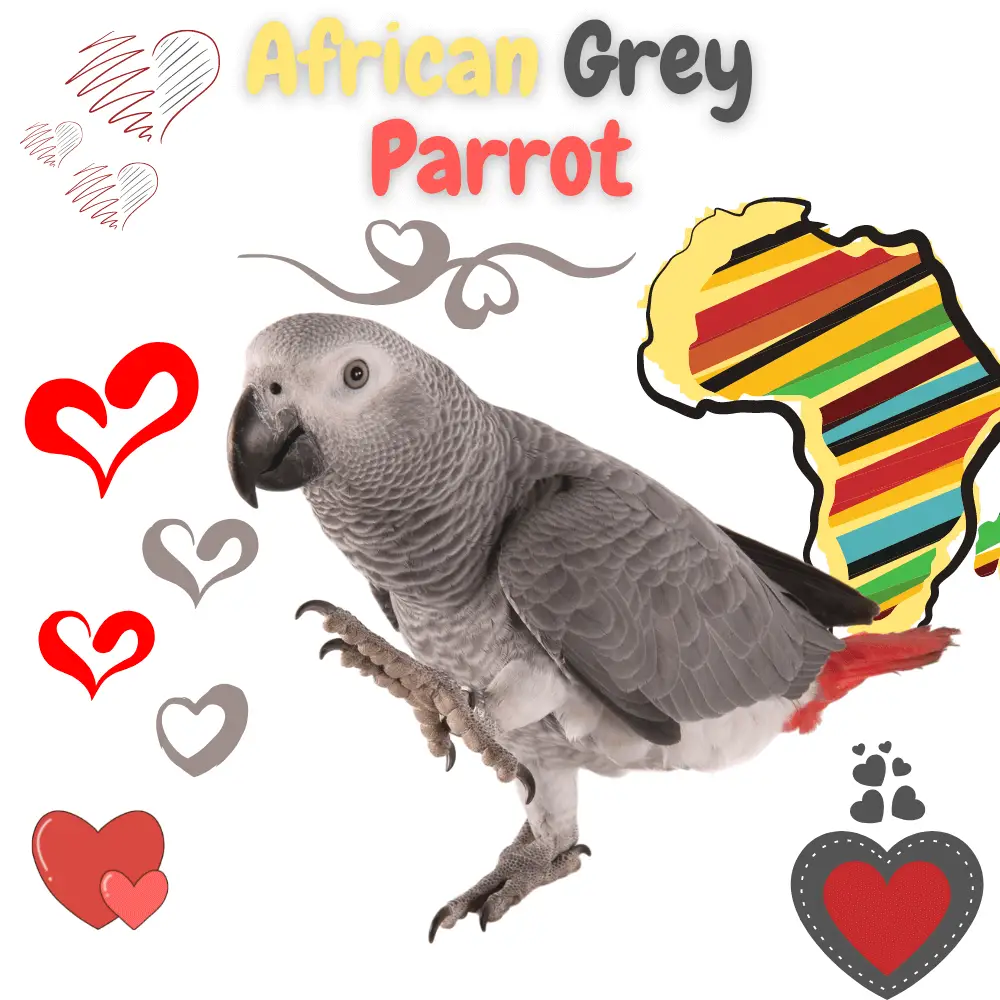
Let’s start with the first parrot that speaks, and certainly one of the best known: the Gray of Gabon.
The african grey parrot(Psittacus erithacus), also known as the african Parrot, inhabits the tropical forests of West Africa. Although much is unknown about its behavior in the wild, it is known to imitate other specimens singing as well as making calls in defense of its territory.
As for what it says in captivity, this animal has been instrumental in demonstrating that many parrots can learn the meaning of certain human words. In 1999, a Gray parrot known as Alex learned to select objects with the shape, color, and composition that his trainer indicated to him. If the required object was absent, the Gray of Gabon indicated it by saying “none”. In addition, Alex has learned to ask his trainer for objects by indicating their characteristics.
This animal is considered one of the most intelligent birds in the world. Despite this, its populations are declining due, above all, to the capture of individuals for sale as pets.

The conure( Eupsitula canicularis ) is distributed throughout southern Mexico and Central America, from Guatemala to Costa Rica. They live in mid-altitude forests, where they form large communities that roost and feed together. To do this, they form foraging groups, as we explained earlier.
They have a very particular behavior; when a group of Red-fronted Parakeet finishes feeding, a few individuals climb to the top of the vegetation and give a ” flight call “. Then the group gathers and they go together in search of more food.
Here are some species of conure parrots:
- Half moon conure
- Peach fronted conure
- Green cheek conure turquoise
- Blue crowned conure
- White-Eyed Conure
- Black capped conure
- Red-Masked Conure
- Blue throated conure
- Crimson bellied conure
- Gold capped conure
- Nanday conure
- Sun conure
- Dusky headed conure
- Jenday Conure
- Pearly conure
- Patagonian conure
Amazon parrot

Another talking parrot is the amazon parrot, which has a similar distribution to the Red-fronted Parakeet. Unlike this one, it inhabits lowland forests which, unfortunately, are increasingly disappearing due to the intensification of agriculture. Additionally, many individuals are captured each year to be sold as pets. For these reasons, the Amazon is on the verge of extinction.
As with other parrots, Amazons have different dialects depending on the geographic area they inhabit. This means that each subpopulation has its own typical sounds. Also, they make different calls when communicating with a bird that is not of their group. There are also gender-specific calls that are reproduced when couples sing together.
Amazons are perhaps the best example of singing parrots. These incredible animals make pair duets. The male and the female produce different sounds that fit together perfectly. Their syllables and speech patterns are learned, as they vary over time.
Here are some species of amazon parrots:
- Red-crowned Amazon
- Lilac-crowned amazon
- Orange-winged amazon
- Yellow-headed amazon
- Yellow-naped amazon
- Turquoise-fronted amazon
- Southern mealy amazon
- White-fronted amazon
- Yellow-shouldered amazon
- Tucumán amazon
- Red-tailed amazon
- Yellow-billed amazon
Budgerigar

The budgie ( Melopsittacus undulatus ) is a small-sized talking parrot species that lives in Australia. Although they may not look like it, they are a good example of talking parrots. In captivity, only males can, with difficulty, imitate human words. This can be explained by their behavior in freedom.
In the wild, males imitate female calls during courtship. They prefer males that have contact calls similar to theirs. For this reason, they must learn to imitate the calls of the female. This process can take several weeks and they must do it every breeding season.
Eclectus parrot
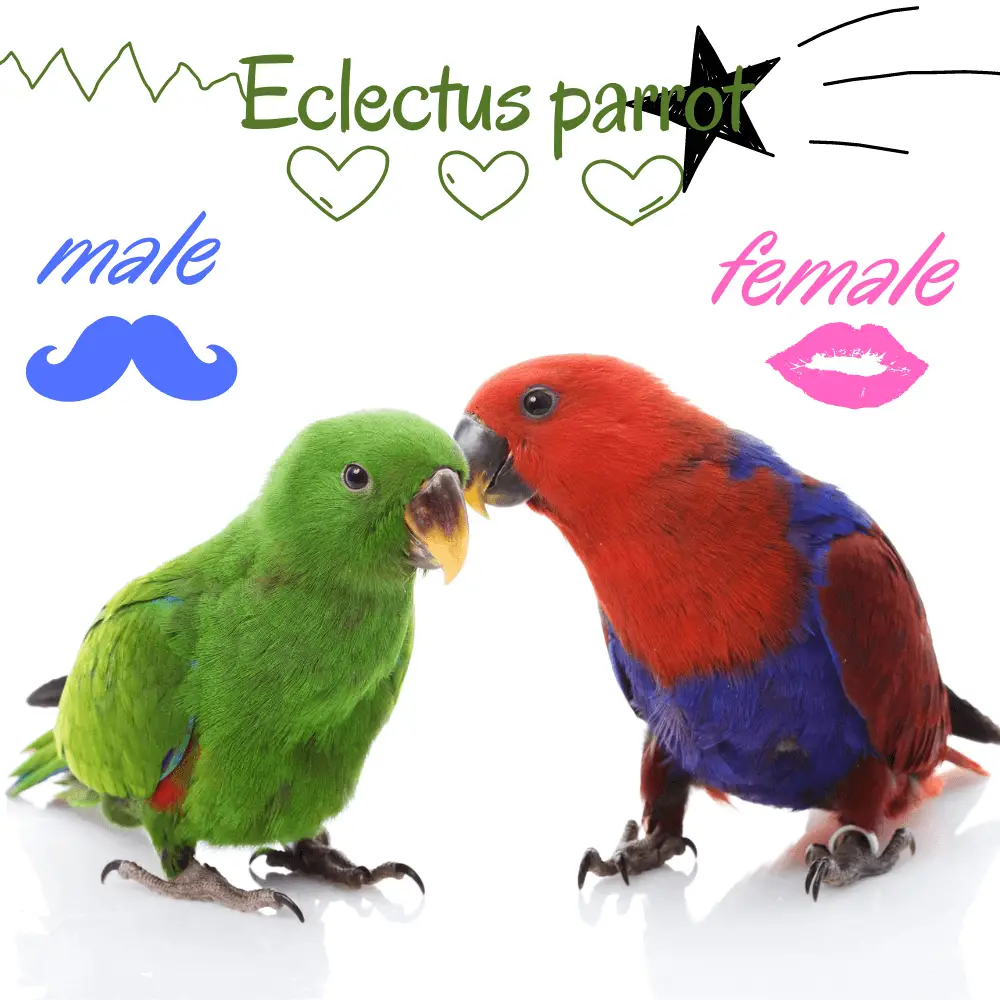
Of all the talking parrot species, the Eclectus parrot (Eclectus roratus) is probably the most talking parrot. This parrot from Australia and other islands in Oceania can learn a wide variety of sounds that it uses in many social contexts.
A peculiarity of this species is its sexual dimorphism. Females are red and blue, while males are green. This is an extremely rare case in birds, where the males are usually more visible. This may be due to the fact that nesting sites are very rare, so it is the females that compete with each other. In fact, it is common for a single female to mate with multiple males (polyandry). When this happens, they cooperate to feed the female and raise the chicks.
Macaws
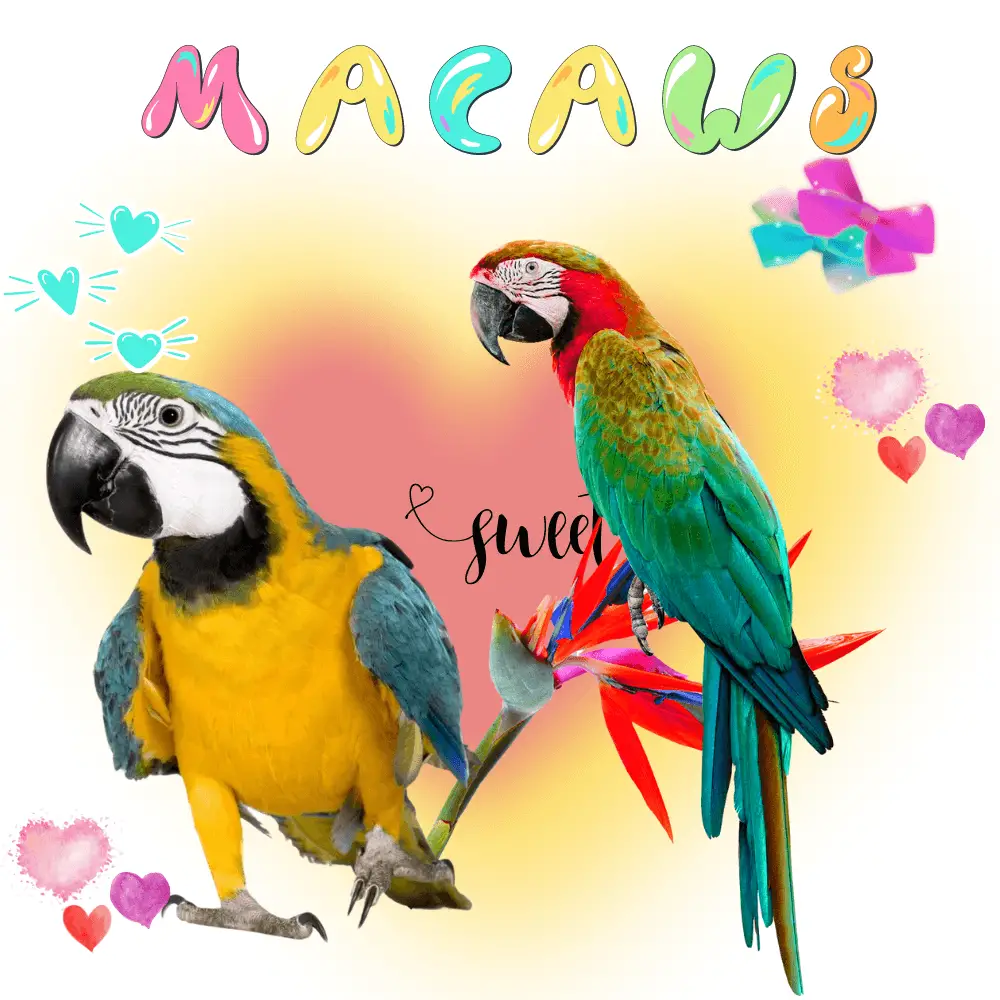
The term macaw includes all parrots belonging to the genus macaw. These are distributed throughout Central and South America. They are the largest of all parrots and excellent imitators. Normally, they are monogamous and fly in very noisy groups for the impressive amount of communication they achieve between them.
Due to their beautiful colors and their ability to imitate the words one uses, this type of talking parrot is extremely popular as a pet. For this reason and because of the loss of their habitat, many species of macaws are in danger of extinction.
Here are some species of macaw parrots:
- Blue Macaw (Ara ararauna).
- Scarlet macaw (Ara macao).
- Military macaws (Ara militaris).
- Green-winged Macaw (Ara chloropterus).
- Spix’s Macaw
- Hyacinth macaw
Cockatoo
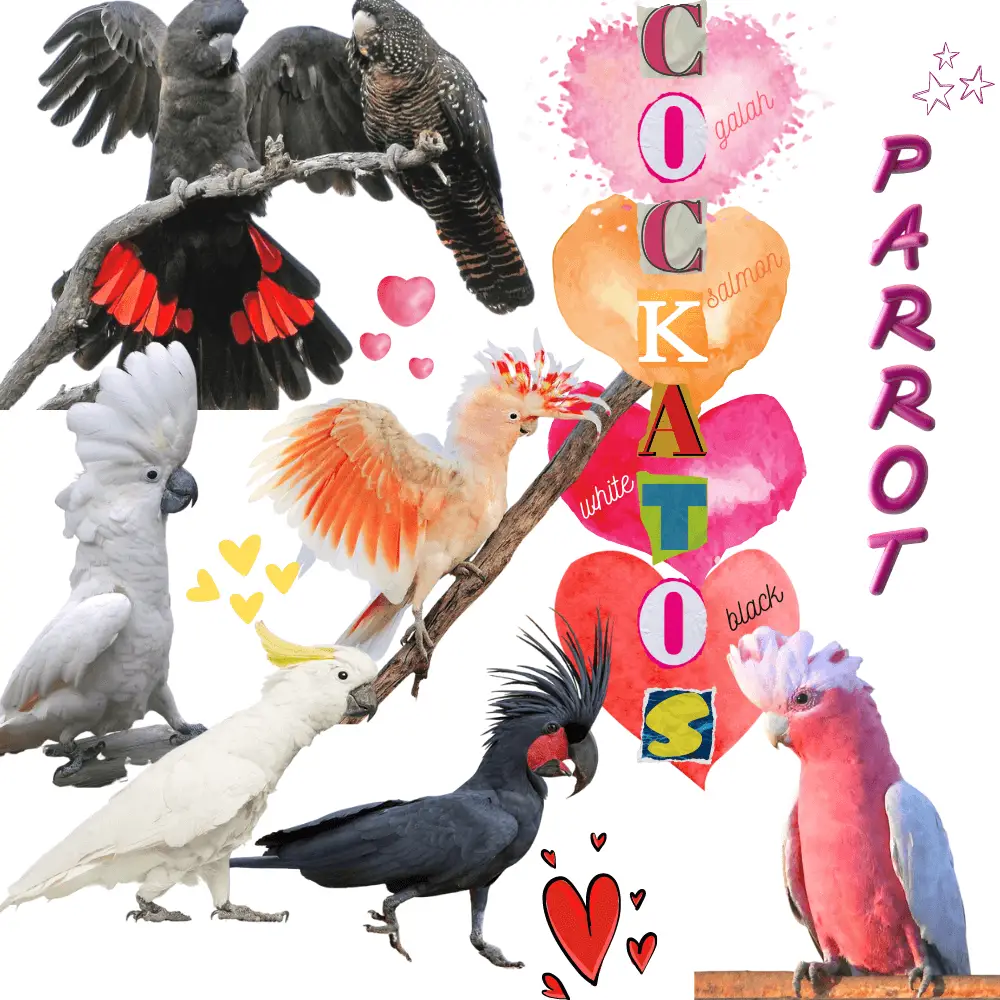
Cockatoos (Cacatuidae) are a family of birds that includes more than 20 species of talking parrots. They are distributed in the islands of East Asia and Oceania, including Australia. Their main characteristic is the tuft of straight, erect feathers that they have on their heads, forming a sort of crest. In addition, they are recognizable by their white or light color, with a few exceptions of black or dark gray color.
The white cockatoo is one of the most popular pets. They have an impressive number of different calls. Also, it is common for them to tap on trees to communicate over long distances, so when you see them it looks like they are dancing.
Here are some examples of cockatoos:
- The white cockatoo.
- Leadbeater’s Cockatoo (Lophochroa leadbeateri).
- Black Cockatoo (Probosciger terrimus).
- Galah Cockatoo (Eolophus roseicapillus).

